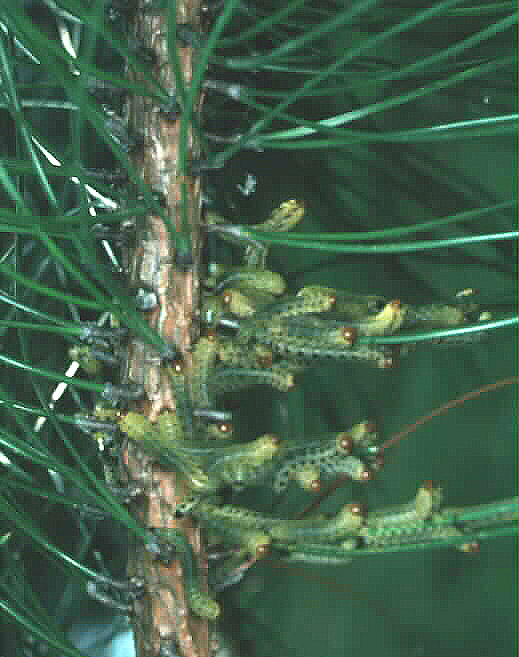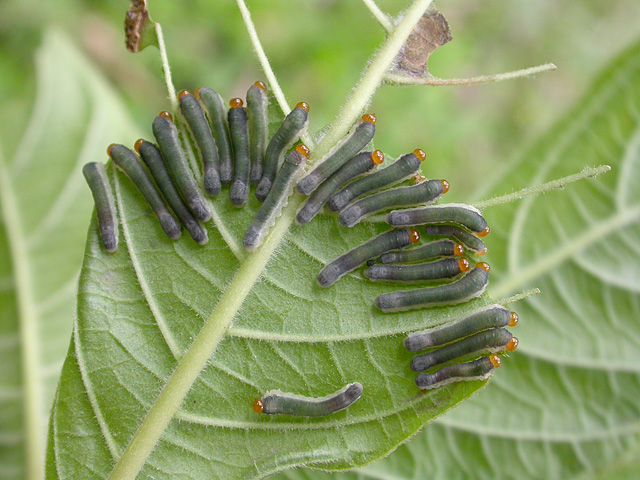James T. Costa, Department of Biology
Western Carolina University, Cullowhee, NC 28723 USA
http://www.wcu.edu/as/biology/costa/Costa.html
| . |
Social Sawflies
James
T. Costa, Department of Biology
Western
Carolina University, Cullowhee, NC 28723 USA
http://www.wcu.edu/as/biology/costa/Costa.html
Larval sawflies are ecological analogs of lepidopteran caterpillars, and so subject to many of the same selective pressures. It's unsurprising, then, that many sawflies have converged on many of the same sociality and chemical defense strategies as lepidopterans. Sociality is found scattered throughout most sawfly families, and in terms of foraging behavior these are all nomadic or patch-restricted foragers sensu Fitzgerald and Peterson (1983). Nomadic sawflies that feed on hardwoods, for example, the tenthredinid Croesus latitarsus, are often leaf edge-feeders that line up along the margin of the leaf they are consuming. Conifer-feeding nomads, like the red-headed pine sawfly Neodiprion lecontei, simply group along twigs and needles, defoliating branches from the apical end inward. The only patch-restricted foraging sawfly group is the web-spinning sawflies, family Pamphiliidae. These insects, represented in North America by the cherry web-spinning sawfly Neurotoma fasciata and related species, are notable for having lost their prolegs, moving by an undulating movement through a silken "trellis" the larvae construct by webbing leaves of the hostplant together.
Chemical Defense
Social species tend to be aposematic and are typically well-defended chemically. Diprionids (conifer sawflies) in North America and pergids in Australia possess diverticular sacs off the foregut in which the insects store hostplant-derived chemicals for defensive use. In the diprionids, the repellent substance is typically a cocktail of terpenoid compounds. When harassed, the insects rear back and mechanically compress the sacs, "ballooning" the sticky, aromatic terpenoids. The pergids, which are Eucalyptus specialists, sequester eucalyptus oil. These conspicuous insects — which can reach 4 or more centimeters in length and whose colonies can number in the tens of thousands — are sometimes called "spitfires" in reference to their ability to eject their eucalyptus oil stores some distance. Another defensive approach is taken by nematine tenthredinids. Most members of this subfamily, common in Europe/Eurasia and North America, have a row of eversible medio-ventral defensive glands on their first seven abdominal segments. Structurally, the invaginated cuticle on these segments forms a reservoir lined by a single layer of glandular cells; upon bending the body hemostatic pressure everts the reservoirs and exposes the volatile compounds (including one or more volatile alcohols, benzaldehydes, aldehydes, cyclic or non-cyclic monoterpenes, or acetates). In all of these groups, chemical defense is preceded or accompanied by a group display, typically rearing part of the body in a threatening way.
Communication in Sawfly Societies
Remarkably
few studies have treated sawfly communication, but what little is known
is remarkable indeed. Two sawfly groups are known to communicate
by means of substrate-borne vibrational cues. Australian pergids,
including Perga affinis and P. dorsalis, for example,
forage
solitarily at night but rest in tight masses on branches of their
hostplant
by day. They apparently find their way back to the group my
tapping
the tree with the sclerotized anal shield at the posterior tip of the
abdomen.
Colony mates tap in return, and in this way the group is reunited.  The
other sawfly known to communicate in this way is the striped alder
sawfly
Hemichroa
crocea, a nematine tenthredinid found on birch and alder throughout
Europe/Eurasia and North America. These edge-feeders repeatedly
curl
and uncurl the posterior portion of the abdomen, drawing it over the
leaf
as they do so. Microscopic peg-like structures found on the
caudal
edge of the anal shield are repeatedly drawn over the leaf surface,
producing
stridulatory pulses. Colonies of this species typically number
20-60
larvae or more, which are naturally distributed among several adjacent
leaves of the host plant. Leaves are exhausted at different
rates,
compelling some larvae to seek fresh food in advance of others in the
colony.
Larvae appear to stridulate most vigorously on fresher foliage unmarred
by feeding damage, and lagging larvae respond to the intensive
stridulation
by orienting to the group at the new feeding site.
The
other sawfly known to communicate in this way is the striped alder
sawfly
Hemichroa
crocea, a nematine tenthredinid found on birch and alder throughout
Europe/Eurasia and North America. These edge-feeders repeatedly
curl
and uncurl the posterior portion of the abdomen, drawing it over the
leaf
as they do so. Microscopic peg-like structures found on the
caudal
edge of the anal shield are repeatedly drawn over the leaf surface,
producing
stridulatory pulses. Colonies of this species typically number
20-60
larvae or more, which are naturally distributed among several adjacent
leaves of the host plant. Leaves are exhausted at different
rates,
compelling some larvae to seek fresh food in advance of others in the
colony.
Larvae appear to stridulate most vigorously on fresher foliage unmarred
by feeding damage, and lagging larvae respond to the intensive
stridulation
by orienting to the group at the new feeding site.
It has long been suspected that some social sawfly groups maintain colony cohesion with chemical markers, a mode of communication demonstrated for many social Lepidoptera. Only the North American red-headed pine sawfly, Neodiprion lecontei, however, has been shown to use chemical cues. These pine feeders systematically defoliate pine branches one at a time before migrating to fresh feeding sites, but the group does not migrate in a single aggregation. Group movement is drawn out from many minutes to hours, yet the group ultimately reaggregates at the new site. Branch choice decisions of later migrants have been shown to be influenced earlier migrants — in other words, these sawflies appear to deposit a marker of some kind. Other studies have shown that tactile cues, physical contact between larvae, also play an important role in establishing feeding sites.
Parental Care and other group behaviors
Some
sawflies are remarkable for maternal defense of eggs or brood.
Pergid
females are well-known to stand guard over eggs and early-instar
larvae,
and will violently attack potential predators. This behavior is
also
found in some curious apterous perreyiine pergids in Papua New Guinea
and
Sulawesi, which brood their eggs under the bark of fallen trees.  Other
sawflies with maternal care include the dielocerine argids Dielocerus
diasi and Themos olfersii in Brazil, the Asian red-headed
spruce
sawfly Cephalcia isshikii, a pamphiliid, and a Japanese
nematine
tenthredinid, Nematus tiliae. Female removal studies in some of
these
species have shown that eggs and brood suffer considerable predation or
parasitism if not actively defended by the female; in no case studied
thus
far, however, have females been shown to perform any parental care
behaviors
but defense.
Other
sawflies with maternal care include the dielocerine argids Dielocerus
diasi and Themos olfersii in Brazil, the Asian red-headed
spruce
sawfly Cephalcia isshikii, a pamphiliid, and a Japanese
nematine
tenthredinid, Nematus tiliae. Female removal studies in some of
these
species have shown that eggs and brood suffer considerable predation or
parasitism if not actively defended by the female; in no case studied
thus
far, however, have females been shown to perform any parental care
behaviors
but defense.
Other
group phenomena found in some sawflies include thermoregulatory
behavior
and group pupation. Perga spp. employ convective cooling in
extreme
heat by expelling a watery fluid from the anus and wiping it over the
venter
of the abdomen with the anal segment. Adjacent larvae in a colony
effectively smear the liquid over one another, presumably increasing
the
efficiency of the device. Group pupation is found in pergids as
well.
The larvae of some species are known to excavate subterranean group
pupation
chambers. William Morton Wheeler and W. M. Mann each reported
observations
in the 1920s of masses of perreyiine pergid larvae moving over the
forest
floor in South America, likening them to "gigantic planaria."
These
larvae were almost certainly seeking a suitable excavation site.
Other South American species, such as dielocerine argids, construct
arboreal
"compound niduses" — group pupation chambers — on tree trunks.
Prior
to spinning their individual cocoons the larvae spin a shell-like
silken
cover that encloses the entire group. For an average-sized colony
these ovate communal pupation structures may be on the order of 5-10 cm
in diameter, but colonies readily fuse into groups of 500 or more
larvae,
and these can construct spectacular overlapping structures extending
over
300 cm2 in area.
 |
| Communally foraging larvae
of the sawfly Waldheimia
interstitialis. Photographed December, 2007 in Costa Rica by Kenji Nishida |
Selected
references for social sawflies
Boevé,J; Gfeller,H; Schlunegger,UP; Francke,W (1997): The secretion of the ventral glands in Hoplocampa sawfly larvae. Biochem. System. Ecol. 25, 195–201.
Boevé,JL; Pasteels,JM (1985): Modes of defense in nematine sawfly larvae: Efficiency against ants and birds. J. Chem. Ecol. 11, 1019–1036.
Boevé,JL (1991): Gregariousness, field distribution and defence in the sawfly larvae Croesus varus and C. septentrionalis (Hymenoptera, Tenthredinidae). Oecologia 85, 440–446.
Costa,JT; Louque,RW (2001): Group foraging and trail following behavior of the red-headed pine sawfly Neodiprion lecontei (Fitch) (Hymenoptera: Symphyta: Diprionidae). Annals Entomol. Soc. Am., in press.
Costa, J.T. and R.W.
Louque.
2001. Group foraging and trail following behavior of the
red-headed
pine sawfly Neodiprion lecontei (Fitch) (Hymenoptera:
Symphyta: Diprionidae).
Annals
of the Entomological Society of America 94: 480-489.
Carne,PB (1962): The characteristics and behaviour of the saw-fly Perga affinis affinis (Hymenoptera). Aust. J. Zool. 10, 1–38.
Codella,SG; Raffa,KF (1993): Defense strategies of folivorous sawflies, pp. 261-294. In M.R. Wagner and K.F. Raffa [eds.], Sawfly Life History Adaptations to Woody Plants. Academic Press, New York.
Dias,BF de S (1975): Comportamento pré-social de Sinfitas do Brasil Central. I. Themos olfersii (Klug) (Hymenoptera, Argidae). Studia Entomol. 18, 401-432.
Dias,BF de S (1976): Comportamento pré-social de Sinfitas do Brasil Central. II. Dieloceros diasi Smith, 1975 (Hymenoptera, Argidae). Studia Entomol. 19, 461-501.
Duffield,RM; Shafagati,A; Riddick,EW; Bowen,S; Wheeler,JW (1990): Mandelonitrile in larval secretion of mountain ash sawfly, Pristiphora geniculata (Hymenoptera: Tenthredinidae). J. Chem. Ecol. 16, 1103–1110.
Eisner,T; Johnessee,JS; Carrel,J; Hendry,LB; Meinwald, J. (1974): Defensive use by an insect of a plant resin. Science 184, 996-999.
Fitzgerald,TD; Peterson,SC (1988): Cooperative foraging and communication in caterpillars. Bioscience 38, 20-25.
Flowers, R.W. and J.T.
Costa.
Larval communication and group foraging dynamics in the red-headed pine
sawfly, Neodiprion lecontei (Fitch) (Hymenoptera:
Symphyta: Diprionidae).
Annals
of the Entomological Society of America, in press.
Ghent,AW (1960): A study of the group-feeding behaviour of the jack pine sawfly Neodiprion pratti banksianae Roh. Behaviour 16, 110-148.
Heitland, W; Pschorn-Walcher, H. (1993): Feeding strategies of sawflies, pp. 93-118. In M.R. Wagner and K.F. Raffa [eds.], Sawfly Life History Adaptations to Woody Plants. Academic Press, New York.
Hograefe,T (1984): Subtrat-Stridulation bei den koloniebildended Blattwespenlarven von Hemichroa crocea (Geoff.) (Hymenoptera: Tenthredinidae). Zool. Anzeiger 213, 234–241.
Kudô,S; Ohara,M; Shinohara,A (1998): Notes on brooding behavior in the sawfly Nematus tiliae (Hymenoptera: Tenthredinidae: Nematinae). J. New York Entomol. Soc. 106, 209–211.
Kudô,S; Maetô,K; Ozaki,K (1992): Maternal care in the red-headed spruce web-spinning sawfly, Cephalcia isshikki (Hymenoptera: Pamphiliidae). J. Insect Behav. 5, 783–795.
Morrow,PA; Bellas,TE; Eisner,T (1976): Eucalyptus oils in the defensive oral discharge of Australian sawfly larvae (Hymenoptera: Pergidae). Oecologia 24, 193–206.
Seymour,RS (1974): Convective and evaporative cooling in sawfly larvae. J. Insect Physiol. 20, 2447–2457.
Shinohara,A (1986): A new apterous sawfly from Sulawesi, Indonesia (Hymenoptera: Pergidae: Perreyiinae), and the pleural origin of the ventral region of the sawfly mesothorax. Syst. Entomol. 11, 247–253.
Weinstein,P; Maelzer,DA (1997): Leadership behaviour in sawfly larvae Perga dorsalis (Hymenoptera: Pergidae). Oikos 79, 450–455.
Wheeler,WM;
Mann,WM (1923): A singular habitat of sawfly larvae. Psyche 30, 9–13.